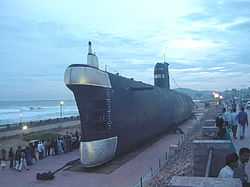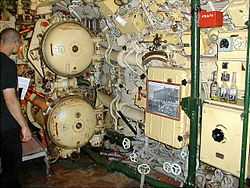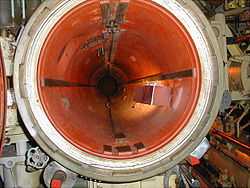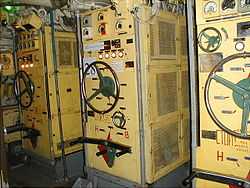Foxtrot-class submarine
 A Cuban Foxtrot underway | |
| Class overview | |
|---|---|
| Builders: | Sudomekh, Leningrad |
| Operators: |
|
| Preceded by: | Zulu-class submarine |
| Succeeded by: | Tango-class submarine |
| Built: | 1957–1983 |
| In commission: | 1958–2000 |
| Completed: | 74 |
| General characteristics | |
| Type: | Submarine |
| Displacement: |
1,952 long tons (1,983 t) surfaced 2,475 long tons (2,515 t) submerged |
| Length: | 89.9 m (294 ft 11 in) |
| Beam: | 7.4 m (24 ft 3 in) |
| Draft: | 5.9 m (19 ft 4 in) |
| Propulsion: |
3 × Kolomna 2D42M 2,000 hp (1,500 kW) diesel engines 3 × Electric motors, two 1,350 hp (1,010 kW) and one 2,700 hp (2,000 kW) 1 × 180 hp (130 kW) auxiliary motor 3 shafts, each with 6-bladed propellers |
| Speed: |
16 knots (30 km/h) surfaced 15 knots (28 km/h) submerged 9 knots (17 km/h) snorkeling |
| Range: |
20,000 nmi (37,000 km) at 8 kn (15 km/h) surfaced 11,000 nmi (20,000 km) snorkeling 380 nmi (700 km) at 2 kn (3.7 km/h) submerged |
| Endurance: | 3-5 days submerged |
| Test depth: | 246–296 m (807–971 ft) |
| Complement: | 12 officers, 10 warrants, 56 seamen |
| Armament: | 10 × torpedo tubes (6 bow, 4 stern)<br/ >22 torpedoes |
The Foxtrot class was the NATO reporting name of a class of diesel-electric patrol submarines that were built in the Soviet Union. The Soviet designation of this class was Project 641.
The Foxtrot class was designed to replace the earlier Zulu class, which suffered from structural weaknesses and harmonic vibration problems that limited its operational depth and submerged speed. The first Foxtrot keel was laid down in 1957 and commissioned in 1958 and the last was completed in 1983. A total of 58 were built for the Soviet Navy at the Sudomekh division of the Admiralty Shipyard (now Admiralty Wharves), St. Petersburg.[1] Additional hulls were built for other countries.
The Foxtrot class was comparable in performance and armament to most contemporary designs. However, its three screws made it noisier than most Western designs. Moreover, the Foxtrot class was one of the last designs introduced before the adoption of the teardrop hull, which offered much better underwater performance. The Foxtrot class was completely obsolete by the time the last submarine was launched. The Russian Navy retired its last Foxtrots between 1995 and 2000,[2] units were scrapped and disposed of for museum purposes.[3] A single unit is still in service in the Ukrainian Naval Forces.





Cuban Missile Crisis
Foxtrots played a central role in some of the most dramatic incidents of the Cuban Missile Crisis. The Soviet Navy deployed four Foxtrot submarines to Cuba. US Navy destroyers dropped practice Depth Charges near Foxtrot subs near Cuba in efforts to force them to surface and be identified. Three of the four Foxtrot submarines were forced to surface, one eluded US forces.[1]
Units
Following is a list of the 58 submarines built during the Soviet Project 641
| Number | Shipyard | Project | Laid down | Launched | Decommissioned | Status |
|---|---|---|---|---|---|---|
| B-94 | Yard 196 Leningrad | 641 | 03.10.1957 | 28.12.1957 | 01.10.1984 | Decommissioned for scrapping[1] |
| B-95 | Yard 196 Leningrad | 641 | 02.02.1958 | 25.04.1958 | 22.02.1980 | Decommissioned for scrapping[1] |
| B-36 | Yard 196 Leningrad | 641 | 29.04.1958 | 31.08.1958 | 24.08.1993 | Decommissioned for scrapping[1] |
| B-37 | Yard 196 Leningrad | 641 | 18.07.1958 | 05.11.1958 | 11.01.1962 | sank after fire and multiple explosions |
| B-133 | Yard 196 Leningrad | 641 | 27.09.1958 | 26.01.1959 | 01.10.1983 | renamed B-833 |
| B-135 | Yard 196 Leningrad | 641 | 20.12.1958 | 30.03.1959 | 01.07.1977 | - |
| B-139 | Yard 196 Leningrad | 641 | 25.02.1959 | 30.05.1959 | 01.10.1976 | renamed B-839 |
| B-116 | Yard 196 Leningrad | 641 | 09.06.1959 | 10.10.1959 | 28.09.1994 | - |
| B-130 | Yard 196 Leningrad | 641 | 22.08.1959 | 17.12.1959 | 01.10.1988 | - |
| B-85 | Yard 196 Leningrad | 641 | 23.12.1959 | 19.03.1960 | 19.04.1990 | - |
| B-59 | Yard 196 Leningrad | 641 | 21.02.1960 | 06.06.1960 | 19.04.1990 | - |
| B-156 | Yard 196 Leningrad | 641 | 20.04.1960 | 02.08.1960 | 19.04.1991 | - |
| B-153 | Yard 196 Leningrad | 641 | 06.08.1960 | 31.01.1961 | 24.06.1991 | renamed B-854 |
| B-164 | Yard 196 Leningrad | 641 | 26.10.1960 | 02.08.1960 | 03.07.1992 | - |
| B-33 | Yard 196 Leningrad | 641 | 03.02.1961 | 27.04.1961 | 24.06.1991 | - |
| B-105 | Yard 196 Leningrad | 641 | 01.07.1961 | 01.10.1961 | 24.08.1993 | - |
| B-169 | Yard 196 Leningrad | 641 | 17.08.1961 | 29.11.1961 | 19.04.1990 | - |
| B-38 | Yard 196 Leningrad | 641 | 30.10.1961 | 31.01.1962 | 25.04.1989 | - |
| B-53 | Yard 196 Leningrad | 641 | 08.01.1962 | 12.04.1962 | 19.04.1990 | renamed B-853 |
| B-50 | Yard 196 Leningrad | 641 | 07.03.1962 | 15.06.1962 | 03.07.1992 | - |
| B-8 | Yard 196 Leningrad | 641 | 09.05.1962 | 21.07.1962 | 19.04.1990 | - |
| B-31 | Yard 196 Leningrad | 641 | 18.08.1962 | 03.11.1962 | 24.06.1991 | - |
| B-2 | Yard 196 Leningrad | 641 | 27.10.1962 | 25.01.1963 | 24.06.1991 | - |
| B-55 | Yard 196 Leningrad | 641 | 22.01.1963 | 05.04.1963 | 03.07.1992 | renamed B-855 |
| B-98 | Yard 196 Leningrad | 641 | 04.04.1963 | 15.06.1963 | 2001 | renamed 292 Wilk |
| B-101 | Yard 196 Leningrad | 641 | 19.06.1963 | 30.08.1963 | 30.06.1993 | - |
| B-6 | Yard 196 Leningrad | 641 | 09.08.1963 | 30.11.1963 | 24.08.1994 | - |
| B-103 | Yard 196 Leningrad | 641 | 14.12.1963 | 16.04.1964 | 24.06.1991 | - |
| B-109 | Yard 196 Leningrad | 641 | 22.02.1964 | 17.06.1964 | 28.09.1997 | - |
| B-107 | Yard 196 Leningrad | 641 | 18.04.1964 | 25.07.1964 | 04.08.1995 | renamed B-807 |
| B-112 | Yard 196 Leningrad | 641 | 19.06.1964 | 27.10.1964 | 19.04.1990 | - |
| B-25 | Yard 196 Leningrad | 641 | 26.08.1964 | 22.12.1964 | 03.07.1992 | - |
| B-205 | Yard 196 Leningrad | 641 | 17.06.1969 | 29.08.1969 | 31.01.1996 | - |
| B-143 | Yard 196 Leningrad | 641 | 21.10.1959 | 17.02.1960 | 24.06.1991 | - |
| B-15 | Yard 196 Leningrad | 641 | 10.10.1963 | 21.02.1964 | 29.10.1992 | - |
| B-427 | Yard 196 Leningrad | 641 | 10.04.1971 | 22.06.1971 | 28.04.1994 | Museum, Long Beach, California, USA |
| B-39 | Yard 196 Leningrad | 641 | 09.02.1967 | 15.04.1967 | 05.07.1994 | Museum, San Diego, California, USA |
| B-440 | Yard 196 Leningrad | 641 | 01.06.1970 | 16.09.1970 | 1999 | Museum, Russia |
| B-435 | Yard 196 Leningrad | 641 | 24.03.1970 | 29.05.1970 | unknown | as U-01 in the Ukraine |
| B-9 | Yard 196 Leningrad | 641 | 26.12.1964 | 31.03.1965 | 17.07.1997 | - |
| B-4 | Yard 196 Leningrad | 641 | 14.06.1960 | 03.10.1960 | 24.06.1991 | - |
| B-57 | Yard 196 Leningrad | 641 | 23.04.1959 | 15.08.1959 | 24.06.1991 | - |
| B-7 | Yard 196 Leningrad | 641 | 14.04.1961 | 29.06.1961 | 19.04.1990 | - |
| B-21 | Yard 196 Leningrad | 641 | 29.10.1964 | 16.02.1965 | 03.07.1995 | renamed B-821, Museum, Zeebrugge, Belgium |
| B-26 | Yard 196 Leningrad | 641 | 06.05.1965 | 10.08.1965 | 24.06.1991 | - |
| B-28 | Yard 196 Leningrad | 641 | 24.05.1965 | 10.08.1965 | 30.06.1993 | - |
| B-34 | Yard 196 Leningrad | 641 | 13.08.1965 | 16.11.1965 | 24.06.1991 | - |
| B-40 | Yard 196 Leningrad | 641 | 24.09.1965 | 16.11.1965 | 30.06.1993 | - |
| B-29 | Yard 196 Leningrad | 641 | 25.03.1966 | 20.05.1966 | 2003 | 1988 renamed 293 Dzik |
| B-41 | Yard 196 Leningrad | 641 | 07.04.1966 | 20.05.1966 | 24.08.1993 | - |
| B-46 | Yard 196 Leningrad | 641 | 13.08.1966 | 24.12.1966 | 30.06.1993 | - |
| B-49 | Yard 196 Leningrad | 641 | 12.10.1966 | 24.12.1966 | 31.12.1993 | Museum, Rochester, Kent, England |
| B-397 | Yard 196 Leningrad | 641 | 07.05.1967 | 22.08.1967 | 30.06.1993 | - |
| B-400 | Yard 196 Leningrad | 641 | 29.05.1967 | 22.08.1967 | 24.09.1991 | - |
| B-413 | Yard 196 Leningrad | 641 | 28.06.1968 | 07.10.1968 | 1999 | Museum, Kaliningrad, Russia |
| B-416 | Yard 196 Leningrad | 641 | 18.07.1968 | 25.02.1969 | 03.07.1992 | - |
| B-213 | Yard 196 Leningrad | 641 | 01.10.1969 | 20.01.1970 | 30.06.1993 | - |
| B-409 | Yard 196 Leningrad | 641 | 18.12.1970 | 02.03.1971 | 30.06.1993 | - |
Operators
Most saw service in the Soviet Navy. Foxtrots were also built for the Indian Navy (8 units, from 1967 to 1974), Libyan (6 units, from 1978 to 1980), and Cuban (6 units, from 1978 to 1983) navies. Some Soviet Foxtrots later saw service in the Polish, and Ukrainian navies.
- Soviet Navy (passed on to successor states)
- Russian navy (ex-Soviet Navy)
- Indian Navy Variants known as Kalvari class, now decommissioned (INS Kursura (S20) converted into a museum)[5]
- Libyan Navy 6 units (2 left but probably abandoned)[6]
- Cuban Navy 6 units
- Ukrainian Navy (ex-Soviet Navy) 1 unit - Zaporizhzhia (U-01)
- Polish Navy 2 units (ex-Soviet Navy)
- ORP Wilk (1987–2003)
- ORP Dzik (1988–2003)
On display
Several Foxtrots are on display as museums around the world, including:
- B-39 at the Maritime Museum of San Diego in San Diego, California, United States.
- B-143 at the Seafront Maritime Theme Park in Zeebrugge, Belgium.
- B-413 at Kaliningrad, Russia.
- B-427 at the RMS Queen Mary in Long Beach, California, United States.
- U-475 Black Widow at Strood, Kent, United Kingdom
- Indian Foxtrot submarine INS Kursura S20 at the Rama Krishna Beach, Visakhapatnam, India.
In popular culture
- A Foxtrot made an appearance in seaQuest DSV in the episode "Whale Song", eco terrorist Max Scully was sinking whaling ships with a secondhand Foxtrot he purchased.
- In the Stargate SG-1 Season 4 premiere "Small Victories", the Replicators take over a Russian Foxtrot codenamed Blackbird.
- In the sci-fi miniseries The Triangle a Foxtrot sub is used for a search mission.
- In the Tom Clancy techno-thriller novel Red Storm Rising Foxtrots are used to strike at NATO convoys in the Atlantic.
- In the BBC Serial Drama Bugs, Series 1 Episode 4, a Foxtrot Submarine is used by the villain.
References
- ↑ 1.0 1.1 1.2 1.3 1.4 Korabli VMF SSSR, Vol. 1, Part 2, Yu. Apalkov, Sankt Peterburg, 2003, ISBN 5-8172-0072-4
- ↑ "Russian Navy". Fas.org. 2008-05-30. Retrieved 2011-12-29.
- ↑ http://www.deepstorm.ru/DeepStorm.files/45-92/dts/641/list.htm
- ↑ All photo's taken inside museum ship acknowledged to User:Mario52
- ↑ Navy decommissions last Kalvari Class submarine INS Vagli
- ↑ "Submarine forces (Libya), Submarines - Submarine forces". Janes. Nov 10, 2010. Retrieved 11 March 2011.
- Miller, David (2002). The Illustrated Directory of Submarines of the World. London: Salamander Books. ISBN 1-84065-375-2.
- А.Б. Широкорад: Советские подводные лодки послевоенной постройки (A.B. Shirokorad: Sowjet Submarines built after WWII) Moscow, 1997, ISBN 5-85139-019-0 (Russian)
- Y. Apalkow: Корабли ВМФ СССР. Многоцелевые ПЛ и ПЛ спецназначания ("Ships of the USSR - Multi-purpose submarines and Special submarines"), St Petersburg, 2003, ISBN 5-8172-0069-4 (Russian)
External links
| Wikimedia Commons has media related to Foxtrot class submarines. |
- http://www.fas.org/man/dod-101/sys/ship/row/rus/641.htm
- http://www.fas.org/man/dod-101/sys/ship/row/rus/index.html
- HNSA Ship Page: Soviet B-413
- Foxtrot Class Submarines - Complete Ship List (English)
- Project 641 at deepstorm.ru (Russian)
- Photos and history of the submarine Foxtrot in Rochester UK
| ||||||||||||||||||||
| ||||||||||||||||||||||||||